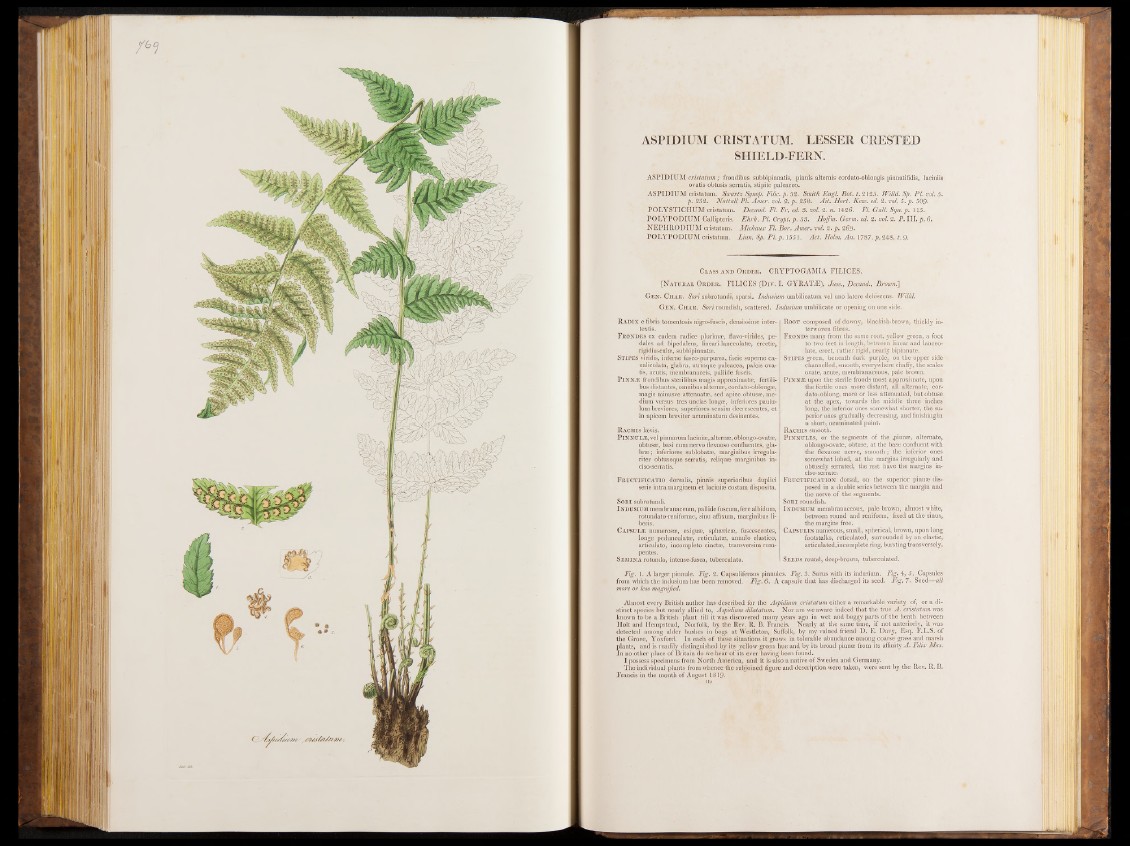
ASPIDIUM CRISTATUM. LESSER CRESTED
SHIELD-FERN.
A S P ID IUM cristatum ; frondibus subbipinnatis, pinnis altérais cordato-oblongis pinnatifidis, laciniis
ovatis obtusis serratis, stipite paleaceo.
A S P ID IUM cristatum. Swartz Synop. Filic.p. 52. Smith Engl. Bot. t. 2125. JVilld. Sp. P I. vol. 5.
p. 252. Nutta ll PI. Amer. vol. 9>.p. 250. A it. Hort. Kew. ed. 2. vql. 5 .p . 509.
PO LY ST ICH UM cristatum. Decand. Fl. Fr. ed. 3. vol. 2. n. 1426. Fl. Gall. S yn .p . 115.
PO LY PO D IUM Callipteris. Ehrh. PI. Crypt.p. 53. Hoffm. Germ. ed. 2. vol. 2. P. I I I . p . 6.
N E PH R O D IUM cristatum. Michaux Fl. Bor. Amer. vol. 2. p. 269•
PO LY PO D IUM cristatum. Finn. Sp. P l .p . 1551. Act. Holm. An. 1787. p . 248. t. 9.
Class a n d Ord e r . CRYPTOGAMIA F IL IC E S .
[N atural Ord er. F IL IC E S (D iv . I. GYRATiE), Juss., Decand., Brown."]
G e n . Ch a r . Sori subrotundi, sparsi. Indusium umbilicatum vel uno latere dehiscens. Willd.
Ge n . Ch a r . Sori roundish, scattered. Indusium umbilicate or opening on one side.
R adix e fibris tomentosis nigro-fuscis, densissime inter-
textis.
F rondes ex eadem radice plurimæ, flavo-virides, pédales
ad biped alem, lineari-lanceolatæ, erectæ,
rigidiusculæ, subbipinnatæ.
St ipe s viridis, inferne fusco-purpurea, facie superne ca-
naliculata, glabra, ulrinque paleacea, paleis ovatis,
acutis, mèmbranaceis, pallide fuscis.
PlNNÆ frondibus sterilibus magis approximatæ, fertili-
bus distantes, omnibus alternæ, cordato-oblongæ,
magis minusve attenuatæ, sed apice obtusæ, medium
vefsus tres uncias longæ, inferiores paulu-
lum breviores, superiores sensim decrescentes, et
in apicem breviter acuminatum desinentes.
R achis lævis.
PlNNULiE, vel pinnarum laciniæ, alternæ, oblongo-ovatæ,
obtusæ, basi cum nervo flexuoso confluentes, gla-
bræ ; inferiores sublobatæ, marginibus irregula-
riter obtuseque serratis, reliquæ marginibus in-
ciso-serratis.
F rüCTIFICATIO dorsalis, pinnis superioribus duplici
serie intra marginetn e t laciniæ costam disposita.
So ri subrotundi.
I ndusium membranaceum, pallide fuscum,fere albidum,
rotundato-reniforme, sinu affixum, marginibus li-
beris.
Capsulas numerosæ, exiguæ, sphæricæ, fuscescentes,
longe pedunculatæ, reticulatæ, annulo elastico,
articulato, incompleto cinctæ, transversim rum-
pentes.
Semina rotunda, intense-fusca, tuberculata.
Root composed of downy, blackish-brown, thickly interwoven
fibres.
F ronds many from the same root, yellow' green, a foot
to two feet in length, between linear and lanceolate,
erect, rather rigid, nearly bi pinnate.
St ipe s green, beneath dark purple^ on the upper side
channelled, smooth, everywhere chaffy, the scales
ovate, acute, membranaceous, pale brown.
PiNNiE upon the sterile fronds most approximate, upon
the fertile ones more distant, all alternate, cor-
dato-oblong, more or less attenuated, but obtuse
at the apex, towards the middle three inches
long, the inferior ones somewhat shorter, the superior
ones gradually decreasing, and finishing in
a short, acuminated point.
Rachis smooth.
P in n u l e s, or the segments of the .pinna», alternate,
oblongo-ovate, obtuse, at the base confluent with
the flexuose nerve, smooth; the inferior ones
somewhat lobed, at the margins irregularly and
obtusely serrated, the rest have the margins in-
ciso-serrate.
Fru ct ifica t io n dorsal, on the superior pinnas disposed
in a double series between the margin and
the nerve of the segments.
So ri roundish.
I ndusium membranaceous, pale brown, almost white,
between round and reniform, fixed at the sinus,
the margins free.
Capsules numerous, small, spherical, brown, upon long
footstalks, reticulated, surrounded by an elastic,
articulated,incomplete ring, bursting transversely.
Seeds round, deep-brown, tuberculated.
Fig. 1. A larger pinnule. Fig. 2. Capsuliferous pinnules. Fig. 3. Sorus with its indusium. Fig. 4, 5. Capsules
from which the indusium has been removed. Fig. 6. A capsule that has discharged its seed. Fig. 7. Seed—-all
more or less magnified.
Almost every British author has described for the Aspidium cristatum either a remarkable variety of, or a distinct
species but nearly allied to, Aspidium dilatatum. Nor are we aware indeed that the true A . cristatum was
known to be a British plant till it was discovered many years ago in wet and boggy parts of the heath between
Holt and Hempstead, Norfolk, by the Rev. R. B. Francis. Nearly at the same time, if not anteriorly, it was
detected among alder bushes in bogs at Westleton, Suffolk, by my valued friend D. E. Davy, Esq. F.L.S. of
the Grove, Yoxford. In each of these situations it grows in tolerable abundance among coarse grass and marsh
plants, and is readily distinguished by its yellow green hue and by its broad pinnae from its affinity A . F ilix Mas.
In no other place of Britain do we hear of its ever having been found.
I possess specimens from North America, and it is also a native of Sweden and Germany.
The individual plants from whence the subjoined figure and description were taken, were sent by the Rev. R. B.
Francis in the month of August 1819.